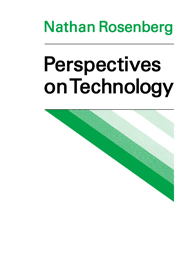Book contents
- Frontmatter
- Contents
- Acknowledgments
- Introduction
- Part 1 Some origins of American technology
- Part 2 The generation of new technologies
- Part 3 Diffusion and adaptation of technology
- Part 4 Natural resources, environment and the growth of knowledge
- 12 Technology and the environment: an economic exploration
- 13 Technological innovation and natural resources: the niggardliness of nature reconsidered
- 14 Innovative responses to materials shortages
- 15 Science, invention, and economic growth
- Epilogue
- Notes
- Index
12 - Technology and the environment: an economic exploration
Published online by Cambridge University Press: 09 January 2010
- Frontmatter
- Contents
- Acknowledgments
- Introduction
- Part 1 Some origins of American technology
- Part 2 The generation of new technologies
- Part 3 Diffusion and adaptation of technology
- Part 4 Natural resources, environment and the growth of knowledge
- 12 Technology and the environment: an economic exploration
- 13 Technological innovation and natural resources: the niggardliness of nature reconsidered
- 14 Innovative responses to materials shortages
- 15 Science, invention, and economic growth
- Epilogue
- Notes
- Index
Summary
Technology is and always has been a two-sided phenomenon. On the one side it encompasses all those forms of knowledge and technique which account for man's growing mastery over his physical environment and for his increasing ability to achieve specific human goals – whether these goals be improved diet, entertainment, shelter, more rapid transportation or communication, the prolongation of human life via an increasingly sophisticated technology of death control, or the prevention of the formation of new lives via the technology of contraception. On the other side, all technologies are accompanied by various side effects, some of which may be unpleasant or dangerous – these the economists call “negative externalities” (there are also positive externalities, but, perhaps characteristically, economists give them much less attention). In the extreme case these negative externalities may be so obnoxious that, by common consent, the activity giving rise to the externality should be terminated. I recall a cartoon strip some time ago in which an allergist was holding a consultation with his patient – Jones – and, at first, congratulating himself on having brought Jones's allergy symptoms under control. Eventually, in the final strip, the allergist concedes, reluctantly, that the treatment produced some rather nasty side effects which would have to be suppressed. Only then do we actually see Jones for the first time: He is approximately three inches tall! The cartoon is funny, obviously, precisely because the costs of the treatment in this case so absurdly outweigh its putative benefits. We instantly – and correctly – reject the employment of a technology to which very costly side effects are attached, as was the case in the thalidomide tragedy of a few years ago.
- Type
- Chapter
- Information
- Perspectives on Technology , pp. 213 - 228Publisher: Cambridge University PressPrint publication year: 1976
- 1
- Cited by



